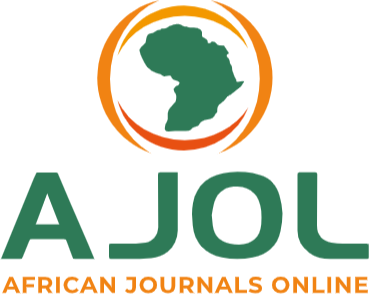Resource Recovery from Maize Biomass for the Synthesis of SiO2 Nanoparticles and Crystallographic Analysis for Possible Applications
DOI:
https://doi.org/10.4314/g5m5q009Keywords:
Crystallographic and amorphous characters, silicon oxide nanoparticles, XRD profiles, analysis, applicationsAbstract
This study demonstrates the successful recovery of silicon dioxide (SiO₂) nanoparticles from maize biomass, highlighting their structural characteristics and environmental implications. Maize waste samples ere obtained as the stocks of the plants after harvesting and employed as precursors for the synthesis of SiO2 nanoparticles using the sol gel method. The produced nanoparticles were analysed for their crystalline properties using XRD machine. The X-ray diffraction (XRD) analysis indicated some structural features, including deviations in diffraction angles (2θ) from standard Quartz (SiO₂), ranging from -0.01° to +0.14°. At 30.28°, a positive deviation of +0.14° indicated lattice contraction, while a negative deviation of -0.01° at 41.80° suggested lattice expansion. These shifts reflect lattice strain, defects, and quantum confinement effects at the nanoscale. Calculated d-spacing values, derived using Bragg’s equation, further emphasized these structural alterations, with deviations ranging from -0.12 Å to +0.01 Å. Notably, d-spacing at 30.28° (2.95 Å) showed compression by -0.12 Å compared to the reference value (3.35 Å), while at 41.80° (2.16 Å), a slight expansion of +0.01 Å was observed. Phase analysis confirmed the crystalline SiO₂ structure, with close alignment to standard Quartz (JCPDS Card Number 46-1045). The lattice parameters, calculated as a = 8.07 Å and c = 3.83 Å, showed minimal deviation from standard Quartz values (a = 8.14 Å and c = 3.83 Å), with a minor contraction of -0.7 Å for lattice constant a. Texture coefficient (TC) analysis revealed preferential crystallographic orientations, with high TC values at 30.28° (1.1176) and 35.20° (1.0649), indicating enhanced electrical conductivity and surface reactivity along these planes. Conversely, weaker diffraction at 20.24° (TC = 0.5098) reflected structural imperfections and non-uniform alignment. The structural features observed in the synthesized SiO₂ nanoparticles underscore their suitability for diverse applications. High surface reactivity, arising from nanoscale effects and lattice strain, supports their use in environmental remediation, such as water purification and heavy metal adsorption. The preferential crystallographic orientations enhance catalytic activity, while the structural integrity and stability ensure effectiveness in soil stabilization and nutrient delivery in agriculture. Additionally, the nanoparticles exhibit potential for incorporation into optoelectronic devices and green construction materials, improving functionality and sustainability. The untilization of maize biomass in this study reveals a sustainable method for SiO₂ nanoparticle synthesis and also addresses environmental concerns by valorizing agricultural waste. The results emphasize the need to control synthesis parameters to optimize properties for targeted applications, presenting a significant step toward sustainable nanotechnology solutions with positive environmental impacts.
Most read articles by the same author(s)
- Aniekan Udongwo, https://dx.doi.org/10.4314/cps.v12i2.17 , Communication In Physical Sciences: Vol. 12 No. 2 (2025): VOLUME 12 ISSUE 2
Similar Articles
- Fabian James Umoren, Mfon Clement Utin, Resource Recovery from Maize Wastes; Synthesis and Characterization of Silicon Oxide Nanoparticles , Communication In Physical Sciences: Vol. 11 No. 3 (2024): VOLUME 11 ISSUE 3
- Irene Edem Johncross, Fanifosi Seyi Josiah, Abidemi Obatoyinbo Ajayi, Resource recovery from Sugar Cane Biomass for the Synthesis of Silicon Nanoparticles , Communication In Physical Sciences: Vol. 12 No. 1 (2024): VOLUME 12 ISSUE 1
- Nsikak Bassey Essien, Chukwu Obaji Daniel, Raphael Mmenyene Paul, Synthesis and characterization of Silicon Oxide Nanoparticles using Plantain Peel as a Precursor , Communication In Physical Sciences: Vol. 11 No. 1 (2024): VOLUME 11 ISSUE 1
- Patricia Adamma Ekwumemgbo, Gideon Adamu Shallangwa, Idongesit Edem Okon, Ibe Awodi, Green Synthesis and Characterization of Iron Oxide Nanoparticles using Prosopis Africana Leaf Extract , Communication In Physical Sciences: Vol. 9 No. 2 (2023): VOLUME 9 ISSUE 2
- Richard Alexis Ukpe, Exploration of Orange Peel Waste as Precursor for the Synthesis and Characterization of highly Crystalline and Mesoporous Silicon Oxide Nanoparticles , Communication In Physical Sciences: Vol. 11 No. 2 (2024): VOLUME 11 ISSUE 2
- Richard Alexis Ukpe, Synthesis and Characterization of Calcium Oxide Nanoparticles (CaO-NPs) from Waste Oyster Shells , Communication In Physical Sciences: Vol. 10 No. 3 (2023): VOLUME 10 ISSUE 3 (2023-2024)
- Mu’awiya Baba Aminu, Andrew Nanfa, Godwin Okumagbe Aigbadon, Simon Dalom Christopher, Idoko Eleojo Friday, Andarawus Yohanna, Abdulbariu Ibrahim, Sadiq Mohammed Salisu, Pam Dajack Dung, Francisco Sokin Paca, Simeon Tobias, Geology, Geochemical and Petrographic Studies of Lokoja Sandstone Facies: Implications on Source Area Weathering, Provenance and Tectonic Settings , Communication In Physical Sciences: Vol. 9 No. 4 (2023): VOLUME 9 ISSUE 4
- Yunusa Habibat, Omoniyi K. Isreal, Stephen Abechi, Aroh A. Oyibo, Owolabi A. Awwal, Imam Naziru, Green Synthesis of Titanium Oxide (TiO2) Nanoparticles Using Phyllanthus Niruri and Assessment of Its Antibacterial Activity in Wastewater Treatment , Communication In Physical Sciences: Vol. 10 No. 1 (2023): VOLUME 10 ISSUE 1
- Nyeneime William Akpanudo, Ojeyemi Matthew Olabemiwo, Pore Parameters Analysis of Echinochloa pyramidalis leaf Dopped Silver Nanoparticles , Communication In Physical Sciences: Vol. 11 No. 4 (2024): VOLUME 11 ISSUE 4
- Comfort M. Ngwu, Stevens A. Odoemelam, Jude C. Nnaji, Chemical synthesis and characterization of zinc, iron and carbon-based nanoparticles and their nanocomposites , Communication In Physical Sciences: Vol. 5 No. 4 (2020): VOLUME 5 ISSUE 4
You may also start an advanced similarity search for this article.




